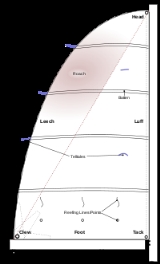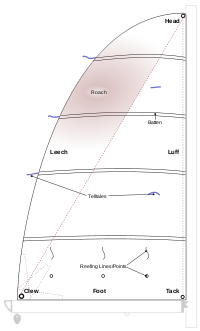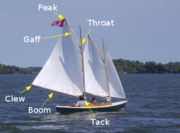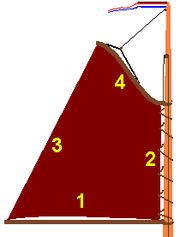
Parts of a sail
Encyclopedia
In sailing
the parts of a sail
have common terminology for each corner and edge of the sail.
 In a triangular sail, the upper point is known as the head; the halyard
In a triangular sail, the upper point is known as the head; the halyard
, the line
which raises the sail, is attached to the head. The lower two corners of the sail, on either end of the foot (the bottom edge of the sail), are called the tack
(forward) and clew (aft). The tack is shackled to a fixed point on the boat, such as the gooseneck
in the case of a Bermuda rig
ged mainsail
, or the deck at the base of a stay, in the case of a jib
or staysail
.
The clew is movable and is positioned with running rigging
. A symmetrical sail may be said to have two clews.
The clew of a jib or other headsail
is the free corner (not attached to any standing rigging
), to which port and starboard jib sheets
are attached to control the angle of the sail to the wind.
In a sail with a boom
(such as a mainsail on a sloop
), the clew is attached to the boom, and can often be tightened along the boom using the outhaul
to adjust the sail shape.
On a square sail
or a symmetrical spinnaker
, each of the lower corners is a clew, but the corner to which the sheet (the working sheet or leeward sheet) is currently attached is called the clew.
may be rigged on the luff of the mainsail to help control the sail shape.
The aft edge of a sail is called the leech. If incorrectly tensioned, the leech of a sail may "flutter" noisily; some larger mainsails are provided with a line which runs along a pocket in the leech, called a leech line, for the purpose of tightening the leech to prevent this fluttering.
Since it cannot be supported by tension in the sail material (applied from the corners), it would flap uselessly unless some other provision was made for it. It is therefore supported by battens, held in batten pockets, which extend into the main portion of the sail.
 Gaff
Gaff
, gunter
, lug, junk
and some sprit
sails have four sides and are set fore-and-aft so that one edge is leading.
The throat is the upper, forward corner of the sail.
 The peak is the upper aft corner. Gaff rigged sails, and certain similar rigs, employ two halyard
The peak is the upper aft corner. Gaff rigged sails, and certain similar rigs, employ two halyard
s to raise the sails: the throat halyard
raises the forward, throat end of the gaff, while the peak halyard
raises the aft, peak end.
The tack is the lower forward corner of the sail.
The clew is the lower aft corner.
The foot, as in a triangular sail, is the bottom edge of the sail, which runs roughly parallel to the deck. The foot is often attached, at the tack and clew, to a boom
; if no boom is present, the sail is said to be "loose-footed."
The head is the upper edge of the sail, and is attached at the throat and peak to a gaff, yard
, or sprit.
The luff is the forwardmost vertical edge of the sail, which runs along the mast.
The leech is the aft vertical edge of the sail.
 Many of the same names are used for parts of a quadrilateral square rig
Many of the same names are used for parts of a quadrilateral square rig
ged sail.
Head : As for a triangular sail, this refers to the topmost part. On a square sail, however, this part is an edge rather than a corner.
Leech : The "side" edge of the sail. Since square sails are symmetrical, they have two leeches. Occasionally, when the ship is close-hauled, the windward edge of the sail might be referred to as the luff.
Clew : Like a triangular sail, the "free" corners of a square sail are called clews; again there are two of them. Square sails have sheet
s attached to their clews like triangular sails, but the sheets are used to pull the sail down to the yard below rather than to adjust the angle it makes with the wind.
Foot : The bottom edge of the sail.
Square sails also have tack
s and sheets, although they are not a part of the sail itself. Square Viking
sails included a stiffening bar called a beitass
.
'Clew lines' are ropes attached to the clews, and 'clewgarnets' or 'cluegarnets' are the tackles
attached to clew lines. These lines and tackles are used to ‘clew up’ the ‘courses
’ of a square sail (i.e. to pull the clews up onto the upper yard
or the mast
in preparation for furling
the sail).
Sailing
Sailing is the propulsion of a vehicle and the control of its movement with large foils called sails. By changing the rigging, rudder, and sometimes the keel or centre board, a sailor manages the force of the wind on the sails in order to move the boat relative to its surrounding medium and...
the parts of a sail
Sail
A sail is any type of surface intended to move a vessel, vehicle or rotor by being placed in a wind—in essence a propulsion wing. Sails are used in sailing.-History of sails:...
have common terminology for each corner and edge of the sail.
The corners

Halyard
In sailing, a halyard or halliard is a line that is used to hoist a sail, a flag or a yard. The term halyard comes from the phrase, 'to haul yards'...
, the line
Rope
A rope is a length of fibres, twisted or braided together to improve strength for pulling and connecting. It has tensile strength but is too flexible to provide compressive strength...
which raises the sail, is attached to the head. The lower two corners of the sail, on either end of the foot (the bottom edge of the sail), are called the tack
Tack (sailing)
Tack is a term used in sailing that has different meanings in different contexts, variously a part of a sail, and an alignment with the wind. When using the latter sense, the maneuver of turning between starboard and port tack is either tacking or jibing....
(forward) and clew (aft). The tack is shackled to a fixed point on the boat, such as the gooseneck
Gooseneck
The gooseneck is the swivel connection on a sailboat by which the boom attaches to the mast. The boom moves from side to side and up and down by swiveling on the gooseneck....
in the case of a Bermuda rig
Bermuda rig
The term Bermuda rig refers to a configuration of mast and rigging for a type of sailboat and is also known as a Marconi rig; this is the typical configuration for most modern sailboats...
ged mainsail
Mainsail
A mainsail is a sail located behind the main mast of a sailing vessel.On a square rigged vessel, it is the lowest and largest sail on the main mast....
, or the deck at the base of a stay, in the case of a jib
Jib
A jib is a triangular staysail set ahead of the foremast of a sailing vessel. Its tack is fixed to the bowsprit, to the bow, or to the deck between the bowsprit and the foremost mast...
or staysail
Staysail
A staysail is a fore-and-aft rigged sail whose luff can be affixed to a stay running forward from a mast to the deck, the bowsprit or to another mast....
.
The clew is movable and is positioned with running rigging
Running rigging
Running rigging is the term for the rigging of a sailing vessel that is used for raising, lowering and controlling the sails - as opposed to the standing rigging, which supports the mast and other spars....
. A symmetrical sail may be said to have two clews.
The clew of a jib or other headsail
Headsail
A headsail of a sailing vessel is any sail set forward of the foremost mast. The most common headsails are staysails, a term that includes jibs and the larger genoa...
is the free corner (not attached to any standing rigging
Standing rigging
On a sailing boat, standing rigging generally refers to lines, wires, or rods which are more or less fixed in position while the boat is under sail. This term is used in contrast to running rigging, which represents elements of rigging which move and change fairly often while under sail...
), to which port and starboard jib sheets
Sheet (sailing)
In sailing, a sheet is a line used to control the movable corner of a sail.- Fore-and-aft rigs:Fore-and-aft rigs comprise the vast majority of sailing vessels in use today, including effectively all dinghies and yachts. The sheet on a fore-and-aft sail controls the angle of the sail to the wind,...
are attached to control the angle of the sail to the wind.
In a sail with a boom
Boom (sailing)
In sailing, a boom is a spar , along the foot of a fore and aft rigged sail, that greatly improves control of the angle and shape of the sail. The primary action of the boom is to keep the foot of the sail flatter when the sail angle is away from the centerline of the boat. The boom also serves...
(such as a mainsail on a sloop
Sloop
A sloop is a sail boat with a fore-and-aft rig and a single mast farther forward than the mast of a cutter....
), the clew is attached to the boom, and can often be tightened along the boom using the outhaul
Outhaul
An outhaul is a line which is part of the running rigging of a sailboat, used to extend a sail and control the shape of the curve of the foot of the sail. It runs from the clew to the end of the boom...
to adjust the sail shape.
On a square sail
Square rig
Square rig is a generic type of sail and rigging arrangement in which the primary driving sails are carried on horizontal spars which are perpendicular, or square, to the keel of the vessel and to the masts. These spars are called yards and their tips, beyond the last stay, are called the yardarms...
or a symmetrical spinnaker
Spinnaker
A spinnaker is a special type of sail that is designed specifically for sailing off the wind from a reaching course to a downwind, i.e. with the wind 90°–180° off the bow. The spinnaker fills with wind and balloons out in front of the boat when it is deployed, called flying. It is constructed of...
, each of the lower corners is a clew, but the corner to which the sheet (the working sheet or leeward sheet) is currently attached is called the clew.
The edges
The foot of a sail is its lowest edge, bounded by the clew and the tack, or on some sails by the two clews. The forward (leading) edge of the sail is called the luff. This is related to the term luffing, which is a condition where the sail ripples because wind is crossing over the front and back side simultaneously, caused when the angle of the wind fails to allow the sail to maintain a good aerodynamic shape; this condition usually starts near the luff as the boat passes through being close-hauled. A cunninghamCunningham (sailing)
In sailing, a cunningham or cunningham's eye is a type of downhaul used on a Bermuda rigged sailboat to change the shape of a sail. Sailors also often refer to the cunningham as the "smart pig"....
may be rigged on the luff of the mainsail to help control the sail shape.
The aft edge of a sail is called the leech. If incorrectly tensioned, the leech of a sail may "flutter" noisily; some larger mainsails are provided with a line which runs along a pocket in the leech, called a leech line, for the purpose of tightening the leech to prevent this fluttering.
The roach
The shape of a sail is seldom a perfect triangle. It is common for sailmakers to add an arc of extra material on the leech, outside a line drawn from the head to the clew. This additional part of the sail is known as the roach; mainsails usually have roaches, but they are very occasionally found on specialized jibs as well. They provide additional power for a given mast/boom size.Since it cannot be supported by tension in the sail material (applied from the corners), it would flap uselessly unless some other provision was made for it. It is therefore supported by battens, held in batten pockets, which extend into the main portion of the sail.
Quadrilateral fore-and-aft sails

Gaff rig
Gaff rig is a sailing rig in which the sail is four-cornered, fore-and-aft rigged, controlled at its peak and, usually, its entire head by a spar called the gaff...
, gunter
Gunter
In sailing, a gunter is used for two main configurations of rig:#The gunter is defined as a wire that leads from one point near the end of a gaff to a point near the other end. A block travels along this wire, and a halyard is attached to this block...
, lug, junk
Junk Rig
The Junk rig, also known as the Chinese lugsail and Sampan rig, is a type of sail rig in which rigid members, called battens, span the full width of the sail and extend the sail forward of the mast....
and some sprit
Spritsail
The spritsail is a form of three or four-sided, fore-aft sail and its rig. Unlike the gaff where the head hangs from a spar along its edge, this rig supports the leech of the sail by means of a spar or spars named a sprit...
sails have four sides and are set fore-and-aft so that one edge is leading.
The corners
Each of the corners on a quadrilateral fore-and-aft rigged sails has its own name:The throat is the upper, forward corner of the sail.

Halyard
In sailing, a halyard or halliard is a line that is used to hoist a sail, a flag or a yard. The term halyard comes from the phrase, 'to haul yards'...
s to raise the sails: the throat halyard
Throat halyard
In sailing, the throat halyard is a line that raises the end of a gaff nearer to the mast, as opposed to the peak halyard which raises the end further from the mast. Such rigging was normal in classic gaff-rigged schooners and in other ships with fore-and-aft rigging. It is absent in Bermuda...
raises the forward, throat end of the gaff, while the peak halyard
Peak halyard
In sailing, the peak halyard is a line that raises the end of a gaff further from the mast, as opposed to the throat halyard which raises the end nearer to the mast. Such rigging was normal in classic gaff-rigged schooners and in other ships with fore-and-aft rigging...
raises the aft, peak end.
The tack is the lower forward corner of the sail.
The clew is the lower aft corner.
The edges
The four edges of a sail are likewise independently named.The foot, as in a triangular sail, is the bottom edge of the sail, which runs roughly parallel to the deck. The foot is often attached, at the tack and clew, to a boom
Boom (sailing)
In sailing, a boom is a spar , along the foot of a fore and aft rigged sail, that greatly improves control of the angle and shape of the sail. The primary action of the boom is to keep the foot of the sail flatter when the sail angle is away from the centerline of the boat. The boom also serves...
; if no boom is present, the sail is said to be "loose-footed."
The head is the upper edge of the sail, and is attached at the throat and peak to a gaff, yard
Yard (sailing)
A yard is a spar on a mast from which sails are set. It may be constructed of timber, steel, or from more modern materials, like aluminium or carbon fibre. Although some types of fore and aft rigs have yards , the term is usually used to describe the horizontal spars used with square sails...
, or sprit.
The luff is the forwardmost vertical edge of the sail, which runs along the mast.
The leech is the aft vertical edge of the sail.
Square Sails

Square rig
Square rig is a generic type of sail and rigging arrangement in which the primary driving sails are carried on horizontal spars which are perpendicular, or square, to the keel of the vessel and to the masts. These spars are called yards and their tips, beyond the last stay, are called the yardarms...
ged sail.
Head : As for a triangular sail, this refers to the topmost part. On a square sail, however, this part is an edge rather than a corner.
Leech : The "side" edge of the sail. Since square sails are symmetrical, they have two leeches. Occasionally, when the ship is close-hauled, the windward edge of the sail might be referred to as the luff.
Clew : Like a triangular sail, the "free" corners of a square sail are called clews; again there are two of them. Square sails have sheet
Sheet (sailing)
In sailing, a sheet is a line used to control the movable corner of a sail.- Fore-and-aft rigs:Fore-and-aft rigs comprise the vast majority of sailing vessels in use today, including effectively all dinghies and yachts. The sheet on a fore-and-aft sail controls the angle of the sail to the wind,...
s attached to their clews like triangular sails, but the sheets are used to pull the sail down to the yard below rather than to adjust the angle it makes with the wind.
Foot : The bottom edge of the sail.
Square sails also have tack
Tack (square sail)
The tack of a square-rigged sail is a line attached to its lower corner. This is in contrast to the more common fore-and-aft sail, whose tack is a part of the sail itself, the corner which is secured to the vessel....
s and sheets, although they are not a part of the sail itself. Square Viking
Viking
The term Viking is customarily used to refer to the Norse explorers, warriors, merchants, and pirates who raided, traded, explored and settled in wide areas of Europe, Asia and the North Atlantic islands from the late 8th to the mid-11th century.These Norsemen used their famed longships to...
sails included a stiffening bar called a beitass
Beitass
A beitass, or stretching pole, is a wooden spar used on Viking ships that was fitted into a pocket at the lower corner of the sail. This innovation was used to stiffen and hold the edge of the sail when sailing close to the wind....
.
'Clew lines' are ropes attached to the clews, and 'clewgarnets' or 'cluegarnets' are the tackles
Block and tackle
A block and tackle is a system of two or more pulleys with a rope or cable threaded between them, usually used to lift or pull heavy loads.The pulleys are assembled together to form blocks so that one is fixed and one moves with the load...
attached to clew lines. These lines and tackles are used to ‘clew up’ the ‘courses
Course (sail)
In sailing, a course is the lowermost sail on a mast.This term is used predominantly in the plural to describe the lowest sails on a square rigged vessel, i.e., a ship's courses would be the foresail, mainsail, and, on the rare occasions in which one is shipped, mizen...
’ of a square sail (i.e. to pull the clews up onto the upper yard
Yard (sailing)
A yard is a spar on a mast from which sails are set. It may be constructed of timber, steel, or from more modern materials, like aluminium or carbon fibre. Although some types of fore and aft rigs have yards , the term is usually used to describe the horizontal spars used with square sails...
or the mast
Mast (sailing)
The mast of a sailing vessel is a tall, vertical, or near vertical, spar, or arrangement of spars, which supports the sails. Large ships have several masts, with the size and configuration depending on the style of ship...
in preparation for furling
Furl (sailing)
Furling refers to stowing or dousing a boat's sail by flaking , packing , roller furling or just lowering it onto the deck. Nowadays, it is becoming more common to use the term "furling" to refer to reefing a sail that is part of a roller furling system....
the sail).

